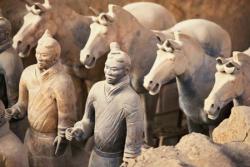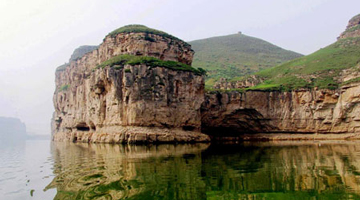Pingyao
Pingyao Overview
-
Pingyao in Shanxi Province, northen China, is a significant Ming Dynasty walled city, with one of the few walls in China remaining intact and now a UNESCO World Heritage site. The city has a 2700 year history. It was the center of China's modern Banking system from 1825, however with the collapse of the Qing Dynasty the banking and finances were transferred to Shanghai and Hong Kong which turned the city into a backwater, saving it from development and preserving its character. The cities' wealth of Chinese traditional buildings include courtyard houses,historic bank courtyard buildings, and more than 3000 historic shops.
Nearby is perhaps China's most famous courtyard complex---"Wangs Great Courtyard" known as the "Forbidden City of Shanxi" a distinctive statement of Qing Dynasty civilian architecture that includes 123 large and small courtyards with 1118 rooms with an area of 45,000 sq.m. The surrounding countryside quite distinctive but clearly climate change in the last 1500 years has affected this area and reduced its richness from the onetime cradle of Chinese civilization.
Best Time to Visit?
-
Situated in the middle of China, the climate here is typically temperate. Winter is cold while summer is usually rainy and hot. April to November is the best time to visit.
How to get there?
-
Plane:
Beijing to Taiyuan HU7372 (20:25-21:30)
Taiyuan to Beijing HU7372 (18:15-19:15) or MU5297 (19:00-20:00)Shanghai Hongqiao to Taiyuan FM9161 (18:45-20:45)
Taiyuan to Shanghai Hongqiao HO1134(19:55-21:45) or FM9162 (21:35-23:15)Train:
Beijing Xi to Pingyao 1163 (19:03-07:31) 12 hours and 28 minutes
Pingyao to Beijing Xi K604(19:25-06:39) 11 hours and 14 minutesThere is no direct train between Shanghai and Pingyao.
What to See?
-
Pingyao Old City
Old city streets
Surrounded by the turtle-like ancient City Wall, Pingyao Old City is like a huge historical museum. Every street or building here has numerous stories to tell about the past one-thousand years.
Shuanglin Temple
Reputed to be the 'ancient painted sculptures museum', Shuanglin Temple houses more than 2,000 colorful sculptures reflecting the exquisite skills of the artisans of the Song, Yuan, Ming and Qing Dynasties. It was included in the World Heritage List by UNESCO as an important cultural site of Ping Yao City in 1997.
Zhenguo Temple
Zhenguo Temple is famous for its building technique and the color-painted sculptures of the Five Dynasties. The most representational is the Ten-Thousand-Buddha Hall, which is one of the three oldest timberworks in mainland China. In order to protect the Ten-Thousand-Buddha Hall from degradation under the eaves, a certain kind of large eave that is far longer and wider than the room itself was adopted when it was built. 'Dougong', a kind building technique, was applied to support the large eave.
Rishengchang Exchange Shop
Rishengchang Exchange Shop is one of the earliest exchange shops in China, located on West Street in Ping Yao City. It was established in 1823 during the Qing Dynasty (1644--1911), and can give an insight into the enterprise and ingenuity of the merchants of ancient China. In particular it will illustrate how the Shanxi Merchants made a vital contribution to the development of Chinese trade.
Useful Information
-
It is almost impossible to purchase a soft sleeper to Pingyao as the train does not originate in Beijing. Hard sleepers on the other hand are very easy to purchase.
More Information
-
People
The population is mostly Han Chinese with minorities of Mongol, Manchu, and Hui.Food
The prestige of Pingyao beef has spread far and wide in China. High in nutritional value, the beef is fresh and tender with a mouthwatering fragrance and a mellow taste..
Shopping
Paper Cuts
Paper cuts are used as decorations for windows, ceilings, lanterns and other objects. They became popular during the Qing Dynasty and have remained fashionable. Some common patterns include a snake encircling a rabbit, pomegranates with their abundant seeds, a frog blowing a bugle, a magpie in a plum tree, mandarin ducks on water, and 'xi' (happiness). There are also characters for marriage including 'living a hundred years,' 'life-long happiness and perfect harmony,' 'happiness has descended upon the house,' 'luck and auspiciousness.' After the People's Republic of China was founded, paper cuttings were exhibited in Pingyao's arts exhibitions every year. Some famous local craftswomen are Cao Qiaoying from Qiaotou Village and Zhang Yuying from Jinghua Village.Cloth shoes
A Chinese saying is that the feet seem to age faster than the rest of the body so to remain healthy, people should take care of their feet. The most distinctive features of handmade cloth shoes are good ventilation and sweat absorption. Their flexibility adapts them to the wearer's feet, making them very comfortable. Children's shoes with embroidered cat or tiger faces on them are called cat- or tiger-shaped shoes, and demonstrate traditional Chinese needlecraft. The cat-shaped shoes are charmingly naive. These auspicious symbols are supposed to ward off evil and prevent calamities, and build wealth and honor. The soft shoes can protect babies' feet well.
-
 Overnight tour to Datong (Grottoes, Hanging Monastery)
Overnight tour to Datong (Grottoes, Hanging Monastery)
-
 Pingyao Town - Raise the Red Lantern
Pingyao Town - Raise the Red Lantern
-
 3-day Tour to Datong (Grottoes) & Xi'an (Terracotta Warriors)
3-day Tour to Datong (Grottoes) & Xi'an (Terracotta Warriors)
-
 Datong (Grottoes) & Pingyao (Fortress Town)
Datong (Grottoes) & Pingyao (Fortress Town)
-
 Shanxi's Laoniuwan Village by Yellow River and Great Wall
Shanxi's Laoniuwan Village by Yellow River and Great Wall
-
 Wutai Shan - The First Among the Four Great Mountains
Wutai Shan - The First Among the Four Great Mountains






